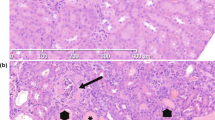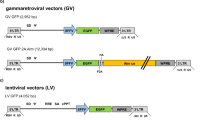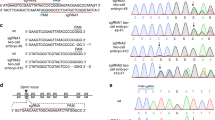Abstract
Research into the basic mechanisms underlying the development of complex multi-system diseases has been facilitated by the study of single gene mutations in experimental animals. Ataxia telangiectasia is such a multifaceted genetically determined disease for which no animal model has been described. It occurs in children and is characterized by varying degrees of immunodeficiency, cerebellar ataxia, oculocutaneous telangiectasia, chronic sinopulmonary disease, endocrine abnormalities, chromosomal aberrations, and a high incidence of neoplasms1–3. Although the clinical manifestations have been well documented, the cause of the disease is unknown. The pleiotropic nature of the ataxia telangiectasia gene is very complex. Many aspects of this disease, including impairment of tissue differentiation in embryological development are not amenable to direct study, thus an animal model for ataxia telangiectasia would be valuable in elucidating the underlying mechanisms, and in developing effective preventive or therapeutic measures. We have recently found a spontaneous mutation of the mouse called ‘wasted’ (wst) that shows pathological changes similar to those of ataxia telangiectasia. This mutation can be recognized at 3 weeks of age by neurological abnormalities. We report here that affected animals show pathological changes in the central nervous and lymphoid systems and exhibit a high degree of spontaneous and γ ray-induced chromosomal damage.
This is a preview of subscription content, access via your institution
Access options
Subscribe to this journal
Receive 51 print issues and online access
$199.00 per year
only $3.90 per issue
Buy this article
- Purchase on Springer Link
- Instant access to full article PDF
Prices may be subject to local taxes which are calculated during checkout
Similar content being viewed by others
References
Paterson, M. C. & Smith, P. J. A. Rev. Genet. 13, 291–318 (1979).
Kraemer, K. H. in DNA Repair Processes, 37–71 (Miami Symp. Spec., 1977).
McFarlin, D. E., Strober, W. & Waldmann, T. A. Medicine 61, 281–314 (1972).
Sweet, H. O. Mouse News Lett. 65, 27 (1981).
Green, M. C. Genetic Variants and Strains of the Laboratory Mouse (Fischer, New York, 1981).
Sidman, C. L., Shultz, L. D. & Unanue, E. R. J. Immun. 121, 2392–2398 (1978).
Marshak-Rothestein, A. et al. J. Immun. 122, 2491–2497 (1979).
Griscelli, C. in Immunodeficiency in Man and Animals, 45–49 (Sinauer, Stamford, Connecticut, 1975).
Miller, T. E., Mackaness, G. B. & Lagrange, P. H. J. natn. Cancer Inst. 51, 1669–1676.
Terplan, K. L. & Krauss, R. F. Neurology 19, 446–454 (1969).
Reed, W. B., Epstein, W. L., Boder, E. & Sedwick, R. J. Am. med. Ass. 195, 746–753 (1966).
Author information
Authors and Affiliations
Rights and permissions
About this article
Cite this article
Shultz, L., Sweet, H., Davisson, M. et al. ‘Wasted’, a new mutant of the mouse with abnormalities characteristic of ataxia telangiectasia. Nature 297, 402–404 (1982). https://doi.org/10.1038/297402a0
Received:
Accepted:
Issue Date:
DOI: https://doi.org/10.1038/297402a0
This article is cited by
-
Identification of therapeutics that target eEF1A2 and upregulate utrophin A translation in dystrophic muscles
Nature Communications (2020)
-
Impaired protein translation in Drosophila models for Charcot–Marie–Tooth neuropathy caused by mutant tRNA synthetases
Nature Communications (2015)
-
Expression of protein elongation factor eEF1A2 predicts favorable outcome in breast cancer
Breast Cancer Research and Treatment (2007)
-
Protein elongation factor EEF1A2 is a putative oncogene in ovarian cancer
Nature Genetics (2002)
-
Chromosomal localization of mouse and human neurotensin receptor genes
Mammalian Genome (1994)
Comments
By submitting a comment you agree to abide by our Terms and Community Guidelines. If you find something abusive or that does not comply with our terms or guidelines please flag it as inappropriate.



